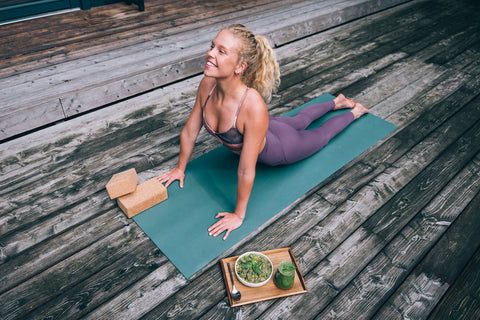Cyclical Nutrition – What are the Benefits?
Was is cyclical nutrition? What should one pay attention to? And how can a plant based diet support you?

The Female Cycle
First and foremost, it’s important to understand how the female reproductive cycle works. Here are some facts:
#1 The reproductive cycle supposedly lasts 28 days. However, deviations from this are very common, and sometimes even the rule! It is very normal for cycle durations to last between 21 and 35 days.
#2 The functioning and duration of the period is based on hormonal influences.
#3 The hormonal cycle causes:
- Changes in the uterine lining the uterine lining changes
- Growth of eggs the ovaries
- Physical changes.
#4 The cycle consists of 4 phases. They are:
Winter – Menstruation
The female hormonal cycle begins with the menstrual phase and lasts an average of 4 days. This phase is characterised by a deficit of the hormone progesterone, which leads to the breakdown of the endometrium via the uterine canal. What remains is an open wound that regenerates during the next phase.
Spring – Follicle phase
The next phase is the follicle phase and lasts approximately 7 days. In preparation for the subsequent ovulation phase, oestrogen levels fall, while FSH and LH rise, and at a later stage, progesterone as well.
Summer - Ovulation
Follicles and the egg in the ovary mature. The increased oestrogen level causes the build-up of the previously degraded endometrium, the uterine canal opens and the cervical mucus becomes fluid. As a result of the subsequent decrease in oestrogen and increase in follicle-stimulating and luteotropic hormones, ovulation occurs between days 12 and 14, which means that the egg is released into the uterus through the fallopian tube, which is covered with hairs. The now open cervix and liquid cervical mucus facilitate the path of sperm into the fallopian tube.
Autumn – Luteal phase
In the last phase of the cycle, which extends from day 15 to 28, the follicle transforms into the corpus luteum and, with the help of LH, produces progesterone, which is essential for the subsequent reconstruction of the uterine lining. In addition: blood vessels, mucous vesicles and tissue structures form to provide a safe environment for a fertilised egg. After ovulation, the uterine canal becomes narrower and the cervical mucus becomes more solid, and the body temperature increases due to the action of progesterone. If the egg was not fertilised, in the final phase - the ischemic phase - the corpus luteum regresses and the progesterone level drops. After this phase, the menstrual phase begins and the cycle starts again.
Cyclical Nutrition
The cycle is controlled by hormones, and it’s possible to influence our hormonal balance. Put simply, what we consume has a direct effect on how women feel during different phases in their cycle.
As we know, a vegan diet can positively influence our metabolism, and even possesses the power to affect individual phases in the female cycle and make the experience more agreeable.
Added bonus: if you suffer from skin breakouts during your cycle, then you’ll be happy with the natural boosting effects of a plant based on your skin. Nourishment from within, and radiance from the outside.
Cyclic nutrition is the roadmap towards less painful periods. This involves a plant-based diet that covers all the nutrients your body needs during individual phases and helps prevent imbalances.
Don’t forget: you should drink plenty of fluids throughout your entire cycle. With our refreshing hacks you can boost your hydration while also consuming valuable nutrients.
We’ve listed important foods with which you can naturally support your cycle.
Winter – Menstruation phase
Feeling sluggish, tired and suffering from cramps? Sounds like your period is saying hello!
During menstruation, you should be sure to include healthy fats into your diet. These are rich in vitamin A which supports the liver in the processing of hormones. Furthermore, they also contain antioxidative properties.
Foods to include:
- Plant based oils (e.g. olive oil, coconut oil)
- Fatty fruit and vegetables such as avocados, carrots, sweet potatoes and berries
- Green kale vegetables like spinach, cabbage and kale
To the blood loss that women experience during this time, the body loses zinc as well as iron. To counteract this, the body needs:
- Red beets
- Nuts
- Legumes: beans, chickpeas,
- Cereals: millet, oats
- Seeds: lin and hemp seeds
- Amaranth
- Stinging nettles
- Arugula
- Dried fruit e.g. apricots
- Superfoods e.g. ginger
To mitigate the effects of cramps, we recommend to eat omega-3 fatty acids and foods that contain magnesium:
- Natural oils e.g. olive oil
- Nuts e.g. almonds, cashews and hazelnuts
- Cereals, especially oats
- Quinoa
- Seeds: pumpkin or sunflower
- Cacao (without additives)
The perfect Every. bowls for this phase:
In case you are overwhelmed by the classic cravings or you find yourself in a hangry state, try and go for a sugar alternative or a healthy snack instead of fast food.
Nice to know: We might not be feeling our best, but our intuition is particularly strong during this phase.
Spring – Follicle phase
Things are starting to look up and so is our energy level. You may also experience a surge in creativity.
During the follicular phase, the body needs support in building the new endometrium and maintaining an optimal hormonal balance. Protein helps here, so opt for foods such as:
- Vegan protein sources: e.g. nuts, lentils
- Cereals e.g. oats or spelt (tasty tip: overnight oats!)
- Legumes: beans, chickpeas, lentils
- Hemp seeds
- Tempeh
- Tofu
To support your gut health and achieve a good hormonal balance, you should also include probiotic foods:
- Vegetables e.g. broccoli, tomatoes, fermented foods
- Fruit e.g. mango, pineapple, plums, peaches, lemons
- Yoghurt
- Apple vinegar
- Miso
- Kimchi
- Kombucha
- Tempeh
Plenty of fruits and vegetables are always a good idea!
The perfect Every. bowls for this phase:
Summer – Ovulation phase
Because we are ovulating, our libido tends to be higher and we feel more energised. Therefore, our body doesn’t need a diet high in calories. During this period, it's possible that we find it easier to interact with people and our communication skills are improved. The time of ovulation can be mastered thanks to fibre and antioxidants. Your body will also welcome light foods like salads and protein during this time.
You should eat plenty of:
- Fruit and vegetables that are rich in calcium such as cauliflower, brussels sprouts, broccoli, arugula and asparagus
- Antioxidant-containing brain foods such as dark berries, pomegranates, apricots, cucumbers, tomatoes, spinach and bell pepper
- Legumes e.g. lentils
- Nuts
- Quinoa
The perfect Every. bowls for this phase:
Autumn – Luteal phase
Your energy decreases, you might be irritable, exhausted and your digestion is going a bit nuts? Then you should rely on starch as fuel, magnesium and calcium against PMS and vitamin B as a booster for your mood!
Tip: Drink a herbal drink during this time, such as nettle tea, which has a draining effect and thus can ease tension in the breasts. Hot chocolate made from raw cocoa without additives warms you from the inside and can improve your mood.
You should eat:
- Fruit and vegetables e.g. apples, bananas, pears, dried fruit, kales, parsnips, pumpkin, potatoes
- Nuts
- Legumes e.g. chickpeas and lentils
- Seeds e.g. linseeds
- Cereals e.g. whole grain pasta
- Natural rice
The perfect Every. bowls for this phase:
No-Gos
What is bad for our cycle? In general, it is recommended to avoid short-chain carbohydrates - especially white sugar - as much as possible during all phases. This is because they cause a blood sugar roller coaster and can upset your hormone balance.

Winter – Menstruation phase
Cramps can be worsened with things like:
- Alcohol
- Fast food
- Coffee
- Unsaturated fats
Luteal phase
The enemies of already low energy levels, onset of fatigue, an emotional down, PMS and digestive problems are foods that cause water retention, such as:
- High in sugar
- High in salt
The cycle and exercise
Physical activity can complement our nutrition and boost our well being: whether it's to fight fatigue and boost energy levels, stimulate healthy appetites, or relieve cramps. So don't be afraid to exercise during your cycle. But even in this case, it's a matter of "knowing how". So here is an overview of the most suitable sports for each cycle phase:
Winter – Menstrual phase
Loosen the abdominal muscles to prevent or relieve pain and cramps with stretching, yoga, walking or running. However, relaxing as well as dynamic exercises are suitable.
Spring & Summer – Follicular and ovulation phase
Thanks to the energy boost during the follicular and ovulation phase, you can go up a gear. Whether it's weight training, running, jump rope, spinning, or challenging workouts, you won't be lacking fuel!
Autumn – Luteal Phase
Now it's time to take it easy! Try not to force yourself to peak performance. A falling energy level can be pleasantly increased with more relaxed cardio, not too heavy weight training or even just a gentle walk or cycle.
In conclusion, our diet is the key to success, even when it comes to the female cycle. A plant based diet that is tailored to the different cyclical phases can boost our well being and help mitigate painful symptoms or ailments.
Discover additional exciting content in the Every. Magazine:
- Nutritious Eating During Postpartum Recovery
- A Strong Immune System With a Healthy Diet
- Go Vegan, Boost Your Metabolism!
- Intermittent Fasting – Eating Like Our Ancestors Did
- Sweet and Nutritious – Our Healthy Dessert Ideas
For even more foodie-content follow us on Instagram and join the Facebook Community to get involved in meal creations and to stay up to date on all things Every.
